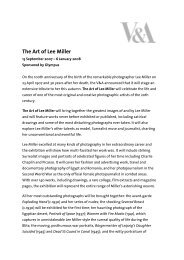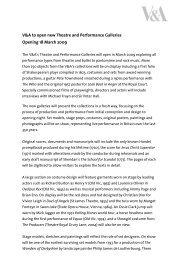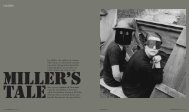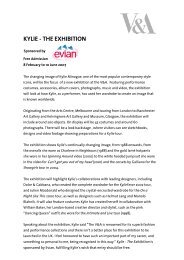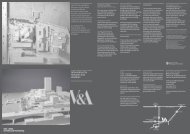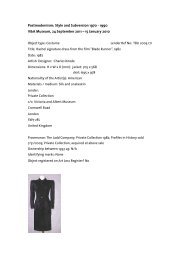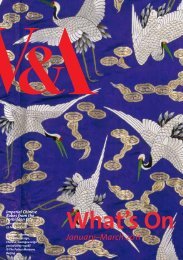jAnE PAVitt - Victoria and Albert Museum
jAnE PAVitt - Victoria and Albert Museum
jAnE PAVitt - Victoria and Albert Museum
Create successful ePaper yourself
Turn your PDF publications into a flip-book with our unique Google optimized e-Paper software.
A Limoges Painted Enamel Casket byJean Limousin, c.1620RACHAEL BRADFORD (renaissance specialism)Monograms are generally interpreted today asmarks of authorship or ownership. A Limogespainted enamel casket, dated around 1620, inthe V&A collections, potentially exhibits bothfunctions. It is monogrammed with the initials ofits maker, Jean Limousin, but also has a rear plaquedevoted entirely to the cipher of Queen Anneof Austria (1601–1666). Indeed, on acquisitionthe casket was believed to have potential royalprovenance, <strong>and</strong> has since been viewed as aprincely treasure by the museum.Through a close investigation of the Limousincasket, this essay attempts to interrogate issues ofownership, <strong>and</strong> expose the potential hazards of‘reading’ monogrammed historical artefacts. Itexplores the function of emblazoned objects <strong>and</strong>reveals that, rather than a simple royal trinket box,the Limousin casket potentially embodies thechanging relations between monarch,manufacturer <strong>and</strong> loyal subject in seventeenthcentury France.Enameling is the ancient art of fusing glass onto ametal plate at high temperature. 1 In the fifteenthcentury, goldsmiths in Limoges perfected thetechnique of ‘painted’ enamels to create enigmaticpictorial effects. Protected by royal edict, theenamellers guarded their techniques within aculture of secrecy <strong>and</strong> by the sixteenth century,painted enamels had become precious ‘objets devertu’, commissioned by royalty <strong>and</strong> oftenemblazoned with coats of arms. 2Iconographic analysis of the casket points to noble,female ownership. Composed of nine plaques, eachimage depicts a secular scene generally conveyingnoble or womanly virtues. The body of the casketshows a ballet, central to court life since itsintroduction by Catherine de Medici. 4 On the lid isThe Triumph of Ceres – the Roman Goddess oftenidentified with both human fertility <strong>and</strong> chastity. 5Also on the lid is Bacchus, directly connected toCeres by the Latin poet Terence (c.185–160 B.C.). Hismotto: ‘Without Ceres <strong>and</strong> Bacchus, Venus wouldfreeze’ was incorporated into Barthelemy Aneau’shugely popular French emblem book of 1552, ‘PictaPoesis/Imagination Poetique’. 6 Its didactic message -without food <strong>and</strong> wine, love will grow cold – wouldnot have been lost on the owner of the casket.The classically inspired scenes are at odds howeverwith the vernacular hunting plaque. Equally, thescale of Bacchus is out of kilter with that of Ceres.Such stylistic discord stems from the fact that thecaskets’ images are entirely derivative, with twocertainly copied directly from prints by Frenchengraver Etienne Delaune. 7 Further, these printedmodels would have been at least fifty years oldwhen used. Rather than an original ‘work of art’then, the casket might be better described as apastiche of images that may well have lookeddated in 1620.Fatua type ware pillow in the shape of a woman reclining,Ming Dynasty 1450–15501Acquisition File: S. M. Franck & Co. Ltd, MA/1/F1203./2.2Vainker, S. J., Chinese Pottery <strong>and</strong> Porcelain: From Prehistory to the Present, (London: British <strong>Museum</strong> Press, 1991), p. 166.See also Medley, Margaret, The Chinese Potter: A Practical History of Chinese Ceramics, (Oxford: Phaidon Press, 1980), p. 207. This ware was moreparticularly associated with enamel wares because of a raised line created with slip which held the glazes in place on the surface during firing.However this is not the case with all fahua-type ware, <strong>and</strong> the technique was not used on the V&A pillow.3Mino, Yutaka, Freedom of Clay <strong>and</strong> Brush through Seven Centuries in Northern China: Tz’u-chou Type Wares 960–1600 A.D.(Indianapolis: Indianapolis <strong>Museum</strong> of Art, 1980), p. 224.4www.kaogu.cn/en/detail.asp?ProductID=2000, [accessed 12 December, 2009]. An archaeological report from the excavationof tombs of the Sui <strong>and</strong> Tang Dynasties at Fengxiang of Shaanxi Province between 1983–1990 reveals that pillows are a commonly found graveitem.5Fernald, Helen E., ‘Chinese Mortuary Pillows in the Royal Ontario <strong>Museum</strong>’, Far Eastern Ceramic Bulletin, Vol. IV, No. 1, (March, 1952),pp. 1–3.6Zhenheng, Wen, ‘Treatise on Superfluous Things’, trans. by Clunas, Craig, Superfluous Things, (Cambridge: Polity Press, 1991), pp. 41–49.7H<strong>and</strong>ler, Sarah, Ming Furniture in the Light of Chinese Architecture, (Berkeley: Ten Speed Press, 2004), p. 61.8H<strong>and</strong>ler, Sarah, Austere Luminosity of Chinese Classical Furniture, (California: University of California Press, 2001), pp. 148-150.9See Mino, Yutaka, Freedom of Clay <strong>and</strong> Brush through Seven Centuries in Northern China: Tz’u-chou Type Wares 960–1600 A.D., (Indianapolis:Indianapolis <strong>Museum</strong> of Art, 1980), pp. 66-67, <strong>and</strong> Vainker, S. J., Chinese Pottery <strong>and</strong> Porcelain: From Prehistory to the Present, (London: British<strong>Museum</strong> Press, 1991), p. 117.10H<strong>and</strong>ler, Sarah, Austere Luminosity of Chinese Classical Furniture, (California: University of California Press, 2001), p. 142.A survey of extant painted enamels dated after1600 however suggests a dramatic fall from favourfor the medium - very few exhibit the coats of armsassociated with aristocratic patronage. Waningpopularity was lamented by famed potter, BernardPalissy, who describes enamels in 1580 as “…contaminated <strong>and</strong> scorned because they are toocommon.” 3 If painted enamels were no longerfashionable in 1580 then, one might ask why woulda casket be commissioned for the queen of Francein 1620?06/07







